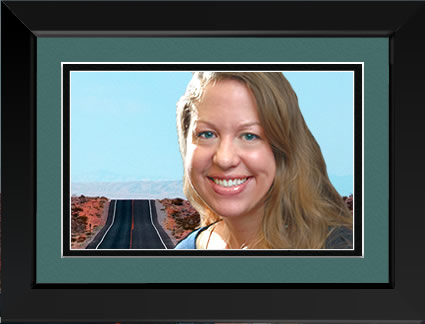In Profile: Dr. Samantha Kahl
Understanding High Speed Human Dimensions
Dr. Samantha Kahl has a need for speed so she can figure out what it does to our environment
and the people and animals that share it. Her work focuses on understanding how the
changes in our world as it gets faster impact our use of natural resources.
What do I mean by a faster world? Once upon a time a road trip meant passing through small towns and seeing local sites. Today it is usually more about long hours spent on a freeway and a pit stop at a big name gas and go. It is great to be able to find out what a platypus eats with just a few clicks and at the same time order a present for cousin Percy on Amazon. But it also means that the library and the small town variety store don't see so many customers and may not be around much longer. With fewer services in small towns, people are drawn to cities. Whether we are happy about it or not our faster world means fewer small towns and larger urban centers with high speed corridors that connect them.
So what does this have to do with managing natural resources like parks, wildlife, and clean water? A lot actually, because it means people use natural resources differently. It turns out that urban dwellers are a lot more interested in watching deer and ducks than eating them and since they don't experience nature on the streets, they rely more on urban parks. Cities also need large supplies of clean water in one area and a good way to deal with a large volume of waste without trashing the environment. In NRM we call these factors human dimensions and they are the focus of Dr. Kahl's studies.
The impacts of humans on their environments are extensive, so her work is on several scales. Here in Lubbock and in surrounding smaller communities she is trying to understand what features draw people and wildlife to our municipal parks. She is especially interested in landscape planning and management for wildlife, in both urban and rural environments and has projects examining questions such as the carrying capacity for waterfowl in man-made stock ponds of the Rolling Plains and the effects of new harvest regulations on pronghorn populations in Texas.
The project Dr. Kahl is most excited about is where the speed comes in. Speed limits that is. She developed a decision tool set, which will help transportation planners understand the impacts of highway placement, size, and speed limits on wildlife communities. When I ask her why, she explains that when these factors are examined well in advance of construction, wildlife impacts can decrease significantly. The exciting part is the quick applicability of her work, "being able to put it to work right away and seeing its effects on the conservation of species and ecosystems" she says.
Working on a large scale means even small changes can make a big difference she explains and most people are more willing to embrace small changes than big ones. She adds that incorporating information on multiple species, "from black bears to land snails", also increases the impact of her work.
Dr. Kahl says the most rewarding part of her job is mentoring students and helping them take advantage of both learning and job opportunities so they can find their niche in Natural Resources Management. In the future she hopes to create more decision-making tools like the one for highway-planning and looks forward to working with government and citizen groups to develop them. She also adds that this sort of modeling, which basically assesses how well connected different habitat patches are, can be used to evaluate the impacts of other human induced changes like urbanization or climate change on wildlife species. As our world continues to accelerate such tools will become more valuable in our efforts to preserve natural resources.
Written by Kate LeVering in collaboration with Samantha Kahl
CONTACT: Samantha Kahl, Department of Natural Resources Management, Texas Tech University
at (806) 834 - 4041 or Samantha Kahl
MORE INFO Dr. Kahl's Faculty Webpage
Department of Natural Resources Management
-
Address
Goddard Building, Texas Tech University, Box 42125, Lubbock TX 79409 -
Phone
806.742.2841 -
Email
nrm@ttu.edu
